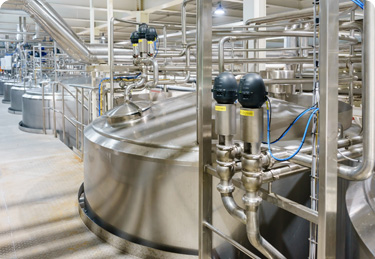Search
COMPARED: A Solvent Vapor Explosion in Germany & a Combustible Dust Explosion in North America

Which is more hazardous: A solvent vapor explosion or a combustible dust explosion?
In this edition of Process Safety Dispatch, we take the opportunity to look at two recent industrial explosions and explore the similarities and the differences between solvent vapor and dust cloud explosions.
Leverkusen, Germany: 9:40am, July 27th, 2021
In July 2021, an explosion occurred in a tank containing solvents at Chempark’s chemical complex in Leverkusen, Germany. At the time of writing, 5 persons are known to have died, one is missing, and 31 persons are reported injured – some seriously. The blast occurred in the storage area of a hazardous waste incinerator, where production residues are collected for disposal. Three solvent storage tanks containing chlorinated solvents caught fire. The Authorities closed roads and warned residents to stay indoors. They also warned of possible release of toxins into the atmosphere, telling residents not to eat fruit and vegetables from their gardens. [Ref 1,2]
Kinson, NC, USA 29th January 2003
Witnesses reported hearing “a sound like rolling thunder”. There was a ‘chain reaction’ of explosions that rapidly propagated through a drug packaging and delivery products manufacturing factory leaving 6 people dead and 36 people injured. The factory was ripped apart by the blast, the shock wave from which broke windows up to 1,000 feet away, and propelled debris as far as 2 miles, some of which started additional fires. A large fire raged for two days at the site of the plant. The blast could be felt 25 miles away. An automated compounding machine using rubber was at the root of the blast, but it was fugitive dust that had collected in difficult to access places that was disturbed, ignited, and helped propagate the dust explosion incident.
Combustible Dust explosions and gas/ vapor explosions have many features in common – but there are important differences. In this Process Safety Dispatch article, we explore the commonalities and differences, referring to the industrial explosions reported above, as a means of improving our understanding of both dust and vapor explosions.
So, which is more hazardous? A combustible dust explosion or a vapor explosion….
Nature of the Explosion Hazard
First let’s look at the nature of the hazards we are considering. We also want to make it plain that while discussing this topic, we are specifically excluding energetic materials from our review. Energetic materials such as Trinitrotoluene (TNT) contain sufficient oxygen in their molecules to be able to decompose explosively (detonate) – with very high energy release.
With reference to Table 1, we start with fire. With pools of flammable solvent, an ignition source can initiate combustion which, depending on the circumstances, can lead to a pool fire that will burn until the ‘fuel’ is consumed, (or oxygen depleted). Similarly with deposits of combustible powders, a fire may also result and continue until the fuel or oxygen is depleted. So far, similarity, and this is illustrated by a comparison of the industrial explosions at Leverkusen and Kinson described above; both explosions lead to long-burning fires.
If pressures are involved, however, then differences begin to emerge. Jet fires represent a major fire risk in installations with pressurized flammable gases and vapors. Jet fires occur when the momentum of escaping gas/ vapor induces turbulent mixing – fuel and air; if ignition occurs, powerful fire jets can result. Jet fires vary with respect to flame length, heat flux and velocities, and important influencing factors are the type and nature of the fuel, pressure and amount of fuel, geometry of the rupture, and surrounding conditions. If the liquid contained in the pressurized vessel reaches a temperature that is higher than its boiling point, then a BLEVE (boiling liquid expanding vapor explosion) becomes a possibility; the containment vessel is at risk of explosion with the potential to cause huge damage and loss of life. Whilst it is the case that dispersed powders under pressure can combust to generate very high turbulence and explosion pressures, and indeed dust explosions involving turbulent jets of burning powder can happen, self-sustaining powder jet fires are not documented. Similarly, powder ‘BLEVEs’ are not a known phenomenon. There is nothing boiling! So here is a difference.
Next, we look at the ability of both bulk liquids and powders to self-heat. We do not know the cause of the solvent tank fire at Leverkusen, but any chemist will tell you that most chemical reactions give rise to heat generation (exothermic). When these are unforeseen and there is no provision for cooling, chemical runaway reaction can occur. An example here is the SEVESO disaster in Italy in 1976 [ref 4] where a thermal runaway occurred during the production of trichlorophenol. With powders, self-heating has similarly produced fires then explosions in industries as diverse as spray milk production, biomass plants, and pharmaceuticals. In both cases, when heat is produced at a rate that exceeds the rate of heat loss by conduction to the surroundings, temperatures rise according to the “Arrhenius” equation, generating an essentially exponential increase in temperature with time. So, both powders and liquids can give rise to thermal runaway situations.
Of course, for both dusts and vapors, fires can transition to becoming explosions as soon as the combustion process has containment. If the vapor is contained in a process vessel, the hot gases of combustion can cause rapid pressure rise, and even vessel rupture. It can be exactly the same for powders that form dust clouds, combusting inside process plant.
[pdf-embedder url=”https://stonehousesafety.com/media/Table-1a-1.pdf” title=”Table 1a”]
Let’s look at ignition properties. Table 2 shows a comparison of material properties for both dusts and vapors/gases. We notice immediately that gases/ vapors can be much more easily ignitable by spark discharges (see Minimum Ignition Energy). We also observe that flammable mixtures can more easily be formed by vapors than dusts. Vapors have flashpoint temperatures, above which ignition of the vapor atmosphere above the liquid surface becomes possible, whereas there is no real equivalent for dusts. Both vapors and dusts have minimum concentration levels below which there is insufficient fuel for explosion. On the other hand, gases and vapors have well defined upper explosion concentration limits, whereas with powders this upper limit, is poorly defined and not practically measurable or useful.
Properties
With powders, of course, particle size matters a lot. The finer the dust, the more hazardous it tends to be. With dusts, we also need something to cause powder dispersion before it is likely to be capable of explosion (does not apply to explosives). And it’s the case that we can ‘see’ potentially combustible dust clouds. A combustible dust cloud is likely to resemble a dense fog. Most flammable vapor clouds will not be visible.
So, what about destructive power of dust explosions vs. vapor cloud explosions? Table 2 shows that dust explosions can be every bit as strong (often stronger) than vapor explosions – see the deflagration indices – ‘Kst/ Kg’. You’ll also see that the explosion pressures that can be generated by both dust explosions and vapor explosions are not too dissimilar, with the highest values occurring with dusts.
Combustible Dust explosions have one feature that sets them apart from vapor explosions, to which a comparison of the 2 industrial explosions above reveals. Dust explosions very often are extended, multiple explosion events; they can readily generate secondary dust explosions, and tertiary and….. This was undoubtedly a feature of the Kinson explosion described above. Dust collected in ventilation systems, above ceiling boards, and from analysis of multiple dust explosions, on floors, ledges, ductwork, and in interconnected vessels is often readily raised by the pressure effects of a primary explosion; multiple explosions follow. We note that unlike the Kinson explosion, with the Leverkusen explosion there were no reports of multiple explosions. It can happen, but dust explosions rarely happen as single explosion events alone.
[pdf-embedder url=”https://stonehousesafety.com/media/Table-2a-1.pdf” title=”Table 2a”]
Wrap-up
So, if you’ve made it to this part of our opinion piece then we owe it to you to answer our starting question: Which is more hazardous: A solvent vapor explosion or a combustible dust explosion?
Well, as the most scrupulous process safety savants will likely agree, it’s not really possible to give a meaningful or direct answer to that question. Both continue to be a part of the landscape of industrial fires and explosions, large and small that occur monthly, weekly, even daily around the world. Both continue to cause multiple injuries and sadly fatalities. However, the role of the process safety professional is to analyze the hazards, considering likelihood and consequences of fire and explosion, to consider and to advise of incident prevention and protection. Process safety is a disciplined framework for managing the integrity of operating systems and processes that handle hazardous substances. It relies on good design principles, engineering and operating and maintenance practices. It deals with the prevention and control of events that have the potential to release hazardous materials and energy.
Let us help you in managing the fire and explosion hazards at your facility. For a no-obligation discussion, please contact us on 609-455-0001 or email us at [email protected].
Ref 1: https://cen.acs.org/safety/industrial-safety/Explosion-Leverkusen-kills-least-2/99/i28
Ref 2: https://www.dw.com/en/leverkusen-chemical-blast-likely-released-toxins-into-air/a-58672832
Ref 3: https://www.csb.gov/west-pharmaceutical-services-dust-explosion-and-fire/
Ref 4: https://www.hse.gov.uk/comah/sragtech/caseseveso76.htm

Get in touch
To learn more about our expertise and services in dust explosion prevention & mitigation, call us at +1 609 455 0001 or email us at [email protected] today.
We also offer tailored virtual and in-company process safety training programs on Dust Explosions, Static Electricity and HAC (Hazardous Area Classification) and more. Find further information here.











